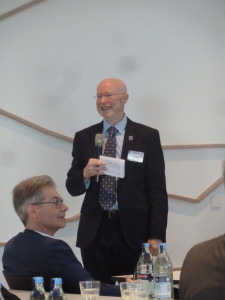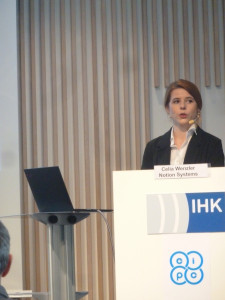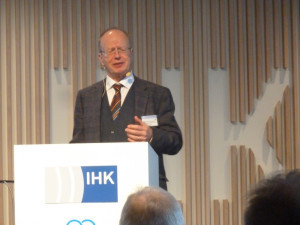After the last EIPC summer conference was held in Munich, the legendary winter conference was also relocated to southern Germany. This time, the trip took us to Villingen in Baden. The program included a special highlight - a visit to Schweizer Electronic in Schramberg.
 Alun MorganTheannounced lecture program of the winter conference met with great interest, so that the rows of chairs at the venue were fully occupied on the first day of the conference. The EIPC had chosen the Haus der Wirtschaft at the Schwarzwald-Baar-Heuberg Chamber of Industry and Commerce Academy, where the audience was able to learn about the latest trends in PCB technology in a modern setting.
Alun MorganTheannounced lecture program of the winter conference met with great interest, so that the rows of chairs at the venue were fully occupied on the first day of the conference. The EIPC had chosen the Haus der Wirtschaft at the Schwarzwald-Baar-Heuberg Chamber of Industry and Commerce Academy, where the audience was able to learn about the latest trends in PCB technology in a modern setting.
After welcoming speeches by EIPC President Alun Morgan and co-host Nicolas-Fabian Schweizer, CEO of Schweizer Electronic, who expressed his delight at his company's international guests, the presentations began at a tight schedule. As always, they will be presented in detail on the EIPC association pages of PLUS in the coming months; therefore only a selection follows here.
Andreas Folge, Nan Ya Plastics Corporation (Taiwan), spoke about the latest developments in IC substrates (Integrated Circuit Substrates). After first explaining the basics (materials, manufacturing methods, packagjng types, properties), he spoke about forecasts for the IC substrate market, which follows developments in the semiconductor market. Accordingly, there was a significant dip in the 2023 financial year compared to the previous year (according to the forecast figures: -9.7% for semiconductors, -26.4% for IC substrates). Folge cited FBGAs (flip chip ball grid arrays) for 2D and 3D packaging, AiP and SiP substrates and the expected growth in flip chip CSPS (FCCSP) and memory chips as upcoming market drivers. Of course, Folge also presented Nan Ya's ultra-thin substrates (2 to 5 μm) and hinted at how Nan Ya's substrate technology will continue to develop. Volker Klafki from Technolam (a distributor of Nan Ya's products) had already written a technical article for PLUS (issue 6/2023) that was well worth reading.
Thomas Gottwald from Schweizer Electronic presented the (Smart) p2 Pack technology for embedding power semiconductors in the PCB. Applications that require high power switching can benefit from p2 Pack (due to the low thermal resistance, low switching losses, lower inductance and robustness). Gottwald mentioned the cooperation between Schweizer and the semiconductor manufacturer Infineon, who are working together on the development of p² PACK Gen 1 (for low and high voltage). Gottwald also discussed the general advantages of IGBTs over SiC mosfets.
Tarja Rapala-Virtanen, EIPC, spoke about the roadmap for the sustainability of printed circuit boards, which is being drawn up by the iNEMI (International Electronics Manufacturing Initiative) research group. Among other things, Rapala-Virtanen discussed a possible circular economy for recycled copper from printed circuit boards. It cannot be reused for printed circuit boards due to microparticles that remain in the copper during production or recycling (or it would simply be uneconomical to clean the copper further). However, it is conceivable that the copper could be used elsewhere. Overall, iNEMI is committed to establishing a circular economy, reducing thecarbon footprint of PCB production and using safer chemicals and new, 'greener' materials. It was striking that there were only a few questions from the audience during this important and topical presentation - overall, there was little enthusiasm for discussion on the first day of the conference.
Excursion to Schramberg
All the more reason for everyone to eagerly await the visit to Schweizer Electronic in Schramberg. The approx. 30 km distance was covered by shuttle bus. At the destination, the conference participants were divided into four groups, warmly welcomed in a showroom and then guided through the extensive factory halls and corridors of the important German PCB manufacturer. Guiding over 100 people in four groups through the production facility without causing too much disruption was a logistical challenge. We were asked to refrain from taking photographs. Instead, one conference participant scribbled diligently on the pages of his notebook (which somewhat alienated some of his companions). In any case, the interest was huge. No wonder: the professionalism of production and the use of state-of-the-art machines at Schweizer aroused enthusiasm.
The evening ended on a warm note with a visit to a restaurant. Here we were able to talk about the conference and the exciting company visit in a relaxed atmosphere.
Second day
The second day of the conference started early again. One highlight was undoubtedly the presentation by Dr. Hayao Nakahara on the market development of IC substrates. As in his PLUS columns, Dr. Nakahara had compiled an impressive amount of data. He also pointed out that by the end of 2023, Huawei could overtake iPhone sales on the Chinese market with its 'Mate 60 Pro' smartphone - also thanks to an application chip with 7 nm technology from HiSilicon and SMIC. This proves how China is continuing to rise in IC technology - major investments are to be expected. The current impressions that Nakahara gained during his recent ten-day visit to Shenzen and which he shared with the conference were exciting - in words and pictures. The increase in electric vehicles (EVs) is clearly visible on the streets there. 100% of buses and cabs are electric, mainly from BYD. A green license mark clearly indicates the type of drive. Overall, it was a particularly fact-filled presentation and the applause was remarkably strong. Although Dr. Nakahara himself was not present, it was clear how highly regarded his expertise is in the PCB industry.
The presentation by Manfred Huschka, who runs a consulting company, seemed like a reprise. He posed the question of whether the 'China + 1' concept can really work. This refers to a cautious move away from an excessive focus on China as a manufacturing location by investing more in other countries - Huschka cited Malaysia, Vietnam, Thailand, India and Mexico as examples, all in the course of 'de-risking' in order to reduce dependencies on China and pay tribute to geopolitical developments. Huschka pointed out that China itself is investing in many of these countries and used the example of Thailand to illustrate the number of existing and planned production facilities. Overall, he doubted that the market situation (apart from IC substrates) justifies all these investments, pointing to infrastructure problems in the countries concerned (such as water supply) and the overcapacities that already exist. According to Huschka's assessment, China will remain the top dog in PCB production. As an additional anecdote, Huschka revealed the secret that even Santa Claus probably doesn't live at the North Pole, but rather in the eastern Chinese city of Yiwu - where 90% of our Christmas decorations are produced. A sobering figure that can probably also be seen as a warning. Overall, Huschka's presentation was particularly lively, as he did not mince his words and at the same time was able to give well-founded reasons for his concerns.
Great need for discussion
 Celia WenzlerTheend of the conference was alsolively. Two presentations on inkjet printing were the most discussed of the event. Celia Wenzler, Notion Systems, gave a basic introduction to this technology; Milena Fritz, SAT Electronic, dealt explicitly with the advantages, but also the stumbling blocks of innovative inkjet printing for the printed circuit board sector. Both presentations were particularly precise, compact and well structured - as if both women had already suspected that they would have to reckon with reservations. A great deal of skepticism was expressed in the ensuing discussion: Isn't this technology too slow, too immature, too crude - and overall a step backwards because multilayering and certain vias are hardly possible? But other voices have also been raised: This is a technology of the future, as has long been recognized in some countries, and the advantages of flexibility, sustainability and cost reduction should not be ignored. It will be worth following up this discussion at LOPEC in Munich. Notion Systems is one of the exhibitors (see p. 146).
Celia WenzlerTheend of the conference was alsolively. Two presentations on inkjet printing were the most discussed of the event. Celia Wenzler, Notion Systems, gave a basic introduction to this technology; Milena Fritz, SAT Electronic, dealt explicitly with the advantages, but also the stumbling blocks of innovative inkjet printing for the printed circuit board sector. Both presentations were particularly precise, compact and well structured - as if both women had already suspected that they would have to reckon with reservations. A great deal of skepticism was expressed in the ensuing discussion: Isn't this technology too slow, too immature, too crude - and overall a step backwards because multilayering and certain vias are hardly possible? But other voices have also been raised: This is a technology of the future, as has long been recognized in some countries, and the advantages of flexibility, sustainability and cost reduction should not be ignored. It will be worth following up this discussion at LOPEC in Munich. Notion Systems is one of the exhibitors (see p. 146).
The finale of the winter conference was refreshing: a 'Quick Fire Walk In' was intended to rekindle the enthusiasm for discussion. EIPC President Alun Morgan himself moderated the format, in which he asked specific questions about selected slides from the summer and winter conferences. A successful idea, especially as the 'firewalkers' did extremely well in the Q&A session.
It can be said that the EIPC Winter Conference rightly attracted a large number of visitors. The international touch, the exciting visit to Schramberg and the overall good atmosphere will be remembered.




